#grimoire tradition
Text
The Grimoire Encyclopaedia
As seen on [my instagram].
My copy of David Rankine’s The Grimoire Encyclopaedia (sic) from Hadean Press arrived today - both volumes. I knew they were going to be big … but 👀 I was not prepared 📚🤣

#TheGrimoireEncyclopaedia#magic#magick#pics#occult#occult books#arcane library#magick book#grimoire#grimoire tradition
29 notes
·
View notes
Text
"In summary therefore, the main conclusions of this thesis are:
i) There is a considerable amount of commonality between the methods and equipment of magic in the PGM, Hygromanteia and Clavicula Salomonis.
ii) There is a clear line of transmission from the Hygromanteia to the Clavicula Salomonis which is identifiable down to the very detailed level of Solomonic method and specific pieces of equipment. Therefore there can be no doubt that the Hygromanteia is the forefather of the Clavicula Salomonis.
iii) There are two main exceptions to the above point:
a) The skrying chapters in the Hygromanteia, have not been passed on to the Clavicula Salomonis. These skrying methods are however found almost word-forword in an 11th century Jewish source. Accordingly, either Jewish sources supplied these chapters to the Hygromanteia, or were derived from it.
b) The pentacles chapters in the Clavicula Salomonis do not derive from the Hygromanteia, but probably come from the manuscript Sepher ha-Otot, or from a related source.
iv) There is no clear line of transmission between the PGM and the Hygromanteia, but the high degree of commonality makes it certain that the PGM was a major contributor to the contents of the Hygromanteia. The Testament of Solomon was also shown to be an
important contributor to the Hygromanteia.
v) A number of magical techniques were identified, such as precise timing of rites by day, hour and Moon phase, strict purification, fasting, use of specific incenses, use of shared nomina magica, and techniques such as threatening spirits with the names of their superiors, or the impersonation of a god to ensure compliance from the spirit.
vi) Equipment used for protection of the magician including the protective floor circle and the phylactery/ourania/lamen, are common to all three texts.
vii) There is a definite sequence to the procedures of ‘Solomonic magic’, foreshadowed in the PGM, but precisely defined in the Hygromanteia and the Clavicula Salomonis, and identified as the ‘Solomonic method.’
viii) The pentacle section of the Clavicula Salomonis was derived from the Sepher ha-Otot, or a cognate Hebrew source. A crude cut-down version of these pentacles was used in the Hygromanteia to construct the ourania/lamen, and the pentacles found in versions
of the Clavicula Salomonis are less detailed, and with less complete Hebrew. Therefore either the Sepher ha-Otot is contributory to both the Hygromanteia and the Clavicula Salomonis, or a common ancestor informed all three texts.
ix) The meaning of -µαντεια as used in chapters 47-58 of the Hygromanteia embraces evocation and skrying as well as just divination.
x) Although Hebraic god names like Adonai, Iaō and Sabaoth are frequently found in the PGM, the Hygromanteia and Clavicula Salomonis, they were divorced from the methods of Jewish magic.
xi) The Sepher Maphteah Shelomoh manuscript of 1700, instead of being evidence of the Jewish roots of Solomonic magic, was in fact a translation of a Latin/Italian manuscript of the Clavicula Salomonis, and therefore not its source.
xii) A full set of correspondences of stones, herbs and beasts, has become split off from the Hygromanteia, prior to 1440, leaving just a few zodiacal and planetary herbal correspondences. These correspondences reappear in other grimoires, such as the Sepher Raziel, or in separate lapidaria, herbaria or bestiaries, but are not carried forward into the Clavicula Salomonis.
xiii) The so-called Mithrasliturgie, is neither a Mithraic text nor the liturgy of any religion, nor is it a magical text, but a procedure for a solitary Mystery rite, designed to confer immortality upon just one initiate.
xiv) A new translation for the Ephesia Grammata has been proposed, as an example of how knowledge of the techniques can sometimes help to decipher the meaning of nomina magica.
Speculative Conclusions about the origins of the Hygromanteia:
xv) The date of composition of the Hygromanteia was probably late 6th/early 7th century, with a major redaction occurring in the early 13th century.
xvi) The place of composition of the Hygromanteia was probably Alexandria, with the text being subsequently taken to Constantinople. The author was Greek educated and not a Christian.
xvii) The Hygromanteia may have been written or compiled by Stephanos of Alexandria (and Athens) in the late 6th century, and brought by him to Constantinople.
xviii) The title Hygromanteia was originally only applied to the last chapters 47-59.
ix) The most likely title of the Hygromanteia is The Magical Treatise of Gathering and Directing the Spirits, or the Magical Treatise, although it was probably originally called the Ἀποτελεσµατικὴ πραγµατεία."
Stephen Skinner, Magical Techniques and Implements present in Graeco-Egyptian Magical Papyri, Byzantine Greek Solomonic Manuscripts and European Grimoires: Transmission, Continuity and Commonality, 2013, pp. 377-379.
11 notes
·
View notes
Text
“Spirit work can be very scattering of your awareness and it’s important that we bring ourselves back to ourselves.
That we stand at this kind of crossroads of all of these options when we do magic. And the idea is to, not just balance on the knife point, of that choice, or chance, or change, but to pick a path.
And to move forward in some way and to orient ourselves. But then to navigate, and to chart, and to navigate those charts that we set.
Right so this notion of centering yourself, what are the experiences that bring you back to yourself in order to pursue those results more thoroughly is part of the ongoing work.”
- Dr. Al Cummins (interview)
43 notes
·
View notes
Text

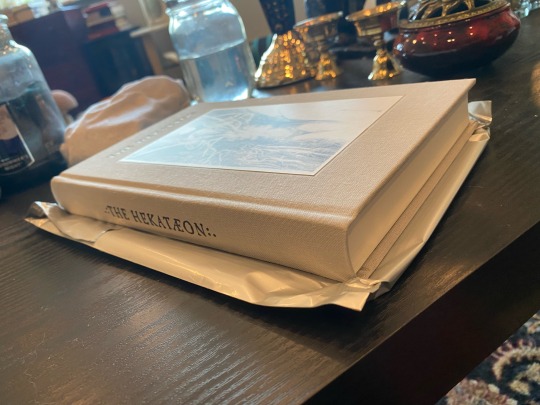
A new bb appears! I ended up with a 2nd Edition, because I can't read, and I love it. It's absolutely, 100% guaranteed to ruin my reading list, but I accept this fully. If I end up wanting to work the grimoire, I may buy another edition when it comes out, but for now this is perfect.
#Hekatæon#hekate deity#jack grayle#ixaxaar#occult books#occultblr#personal library#grimoire tradition#grimtrad
16 notes
·
View notes
Text
Herb's Properties
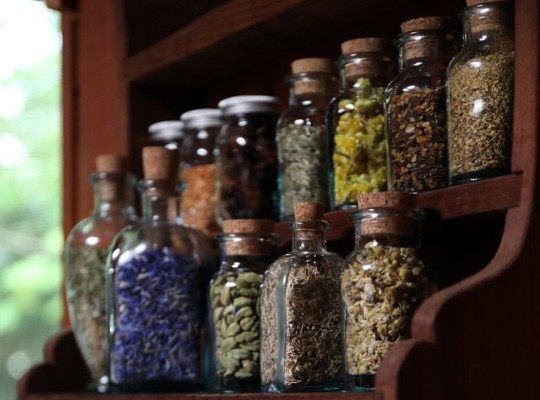
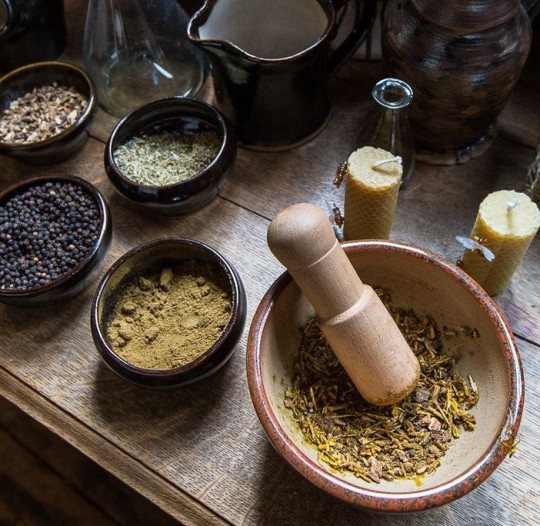
Basil: money, luck, prosperity, happiness
Bay Leaf: energy, cleansing, can be charged with almost any intention
Camomile: Caring, kindness, luck, growth, self-love growth, confidence, avoiding negativity, happiness
Cinnamon: passion, quick success, fire magick
Chia seeds: Growth, health, kindness, Property
Chilli flakes: Pride, confidence, power, strength, Passion
Cumin: Courage, bravery, protection, loyalty
Dandelion: wishes, charisma, success, good luck
Dill: sexual love, luck, protection
Eucalyptus: cleansing, healing, purifying, relaxing, comfort
Fennel: hate, anger
Flax seeds: Prosperity, growth, new beginnings
Ginger: fiery passion, success, and personal power
Jasmine: love, dreams, sensuality, luxury and kindness
Lavender: love and attraction, purification, relaxation, restful sleep
Nutmeg: luck, Health, Fidelity, Love, Prosperity, comfort, loyalty
Oregano: comfort, love, warmth
Paprika: Pride, confidence, power, strength
Parsley: Cleansing. purification
Peppermint: healing, purification, love and energy, cleansing, prosperity
Poppy seeds: protection, intuition, self-assurance, hexing and cursing
Rose: love, beauty, harmony, romance, attraction
Rosemary: cleansing, purification, wisdom, protection
Sesame seeds: Prosperity, growth, health, nurturing
Spearmint: love, cleansing, renewal, blessing
Sunflower seeds: happiness, growth, joy
Thyme: beauty, strength, courage
Turmeric: confidence, creativity, energy
Vanilla: love and sexuality
tip jar
#thecupidwitch#witchcraft#witch community#witches#witchcore#witch#witchblr#green witch#grimoire#herbs#book of shadows#wicca#pegan#peganism#wiccablr#pagan wicca#wiccan#magic#ko fi support#baby witch#beginner witch#chaos witch#eclectic witch#folk witchcraft#hedge witch#kitchen witch#tarot witch#traditional witchcraft#witch aesthetic#plants and herbs
2K notes
·
View notes
Text
September 2023 witch guide
September 2023 witch guide
Full moon: September 29th
New moon: September 14th
Sabbats: Mabon September 23rd
September Harvest Moon
Also known as: Autumn moon, falling leaves moon, song moon, leaves turning moon, moon of brown leaves, yellow leaf moon, wine moon & Full corn moon
Element: Earth
Zodiac: Virgon& Libra
Animal spirits: Trooping Faeries
Deities: Brigid, Ceres, Ch'ang-o, Demeter, Freya, Isis & Vesta
Animals: Jackal & snake
Birds: Ibis & sparrow
Trees: Bay, hawthorn, hazel & larch
Herbs/plants: Copal, fennel, rye, skullcap, valerian, wheat & witch hazel
Flowers: Lily & Narcissus
Scents: Bergamot, gardenia, mastic & storax
Stones: Bloodstone, chrysolite, citrine, olivine, peridot & sapphire
Colors: Browns, dark blue, greens & yellows ( Earth tones)
Energy: Balance of light & dark, dietary matters, employment, health, intellectual pursuits, prosperity, psychism, rest, spirituality, success & work environments. Also cleaning & straightening mentally, physically & spiritually.
Technically, the Harvest Moon is the Full Moon closest to the September equinox around September 21st. The Harvest Moon is the only Full Moon name determined by the equinox rather than a month. Most years, it’s in September, but around every three years, it falls in October.
In September, the Full Moon is the Corn Moon from the Native American tribes harvesting their corn. It can also be the Harvest Moon, which corresponds with the Anglo-Saxon name, while Celtic and Old English names are Wine Moon, Song Moon, and Barley Moon.
Mabon
Also known as: Autumn Equinox, Cornucopia, Witch's Thanksgiving & Alban Elved
Season: Fall
Symbols: Acorns, apples, autumn leaves, berries, corn, cornucopia (horn of plenty), dried seeds, gourds, grains, grapes, ivy, pine cones, pomegranates, vines, wheat, white roses & wine
Colors: Blue brown, drk red, deep gold, gold, indigo, lead green, maroon, orange, red, russet, violet & yellow
Oils/incense: Apple, apple blossom, benzoin, black pepper, hay/straw, myrrh, passion flower, patchouli, pine, red poppy & sage
Animals: Dog, goose, hawk, swan, swallow & wolf
Stones: Agate, amethyst, carnelian, lapis lazuli, sapphire, yellow Agate & yellow topaz
Foods: Apples, blackberries, blackberry wine, bread, carrots, cider, corn, cornbread, grapes, heather wine, nuts, onions, pomegranates, potatoes, squash, vegetables, wheat & winw
Herbs/plants: Acorn, benzoin, cedar, corn, cypress, ferns, grains, hazel, hops, ivy, myrrh, oak, pine, sage, sassafras, Salomon's seal, thistle, tobacco & wheat
Flowers: Aster, heather, honeysuckle, marigold, milkweed, mum,passion flower& rose
Goddesses: Danu, Epona, Modron, Morrigan, Muses, Pomona, Persephone, Sophia & Sura
Gods: Esus, Green Man, Hermes, Mabon, Mannanan, Toth & Thor
Issues, Intentions & Powers: Accomplishment, agriculture, balance, goals, gratitude & grounding
Spellworks: Balance, harmony, protection, prosperity, security & self confidence
Related festivals:
• Sukkot- is a Torah-commanded holiday celebrated for seven days, beginning on the 15th day of the month of Tishrei. It is one of the Three Pilgrimage Festivals (Hebrew: שלוש רגלים, shalosh regalim) on which those Israelites who could were commanded to make a pilgrimage to the Temple in Jerusalem. In addition to its harvest roots, the holiday also holds spiritual importance with regard to its abandonment of materialism to focus on nationhood, spirituality, and hospitality, this principle underlying the construction of a temporary, almost nomadic, structure of a sukkah.
• Mid-Autumn festival- also known as the Moon Festival or Mooncake Festival, is a traditional festival celebrated in Chinese culture. Similar holidays are celebrated by other cultures in East & Southeast Asia. It is one of the most important holidays in Chinese culture; its popularity is on par with that of Chinese New Year. The history of the Mid-Autumn Festival dates back over 3,000 years. The festival is held on the 15th day of the 8th month of the Chinese lunisolar lunisolar calendar with a full moon at night, corresponding to mid-September to early October of the Gregorian calendar. On this day, the Chinese believe that the Moon is at its brightest and fullest size, coinciding with harvest time in the middle of Autumn.
• Thanksgiving- This is a secular holiday which is similar to the cell of Mabon; A day to give thanks for the food & blessings of the previous year. The American Thanksgiving is the last Thursday of November while the Canadian Thanksgiving is celebrated in October
• Festival of Dionysus- There were several festivals that honored Dionysus, the God of wine. It was a time of fun, games, feasting & drinking wine.
Activities:
•Scatter offerings in a harvested fields, Offer libations to trees
• Decorate your home and/or altar space for fall
• Bake bread
• Perform a ritual to restore balance and harmony to your life
• Cleanse your home of negative energies
• Pick apples
• Have a dinner or feast with your family and/or friends
• Set intentions for the upcoming year
• Purge what is no longer serving you
•Take a walk in the woods
• Enjoy a pumpkin spice latte
• Donate to your local food bank
• Gather dried herbs, plants, seeds & pods
• Learn something new
• Make wine
• Brew an apple cinnamon simmer pot
• Create an outdoor Mabon altar
•Adorn burial sites with leaves, acorns, & pinecones to honor those who have passed over & visit their graves
Many cultures see the second harvest (after the first harvest Lammas) and equinox as a time for giving thanks. This time of year is when farmers know how well their summer crops did, and how well fed their animals have become. This determines whether you and your family would have enough food for the winter. That is why people used to give thanks around this time, thanks for their crops, and animals, and food.
The name Mabon comes from the Welsh God, who was the son of the Earth Mother Goddess. However, there is evidence that the name was adopted in the 1970s, and the holiday was not originally a Celtic celebration.
Some believe Night and day are of equal legth and the God's energy & strength are nearly gone . The Goddess begins to mourn the loss she knows is coming, but knows he will return when he reborn at Yule.
Sources:
Farmersalmanac .com
Wikipedia
Llewellyn's Complete Book of Correspondences by Sandra Kines
A Witch's Book of Correspondences by Viktorija Briggs
Mabon: Rituals, Recipes & Lore for the Autumn Equinox Llewellyn's Sabbat Essentials
#witchcraft#wheel of the year#sabbat#mabon#Corn moon#Harvest moon#witchblr#wiccablr#paganblr#pagan#Wicca#grimoire#spellbook#book of shadows#witches of tumblr#tumblr witch#moon magic#witch tips#witch guide#traditional witchcraft#witch community#witch society#witchy things#witches#witch friends#greenwitchcrafts#All witches#correspondence#witchyvibes#witchcore
706 notes
·
View notes
Text
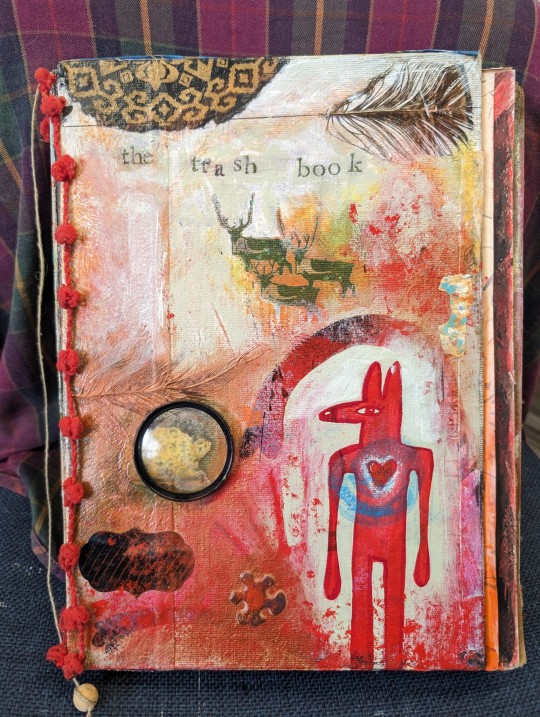

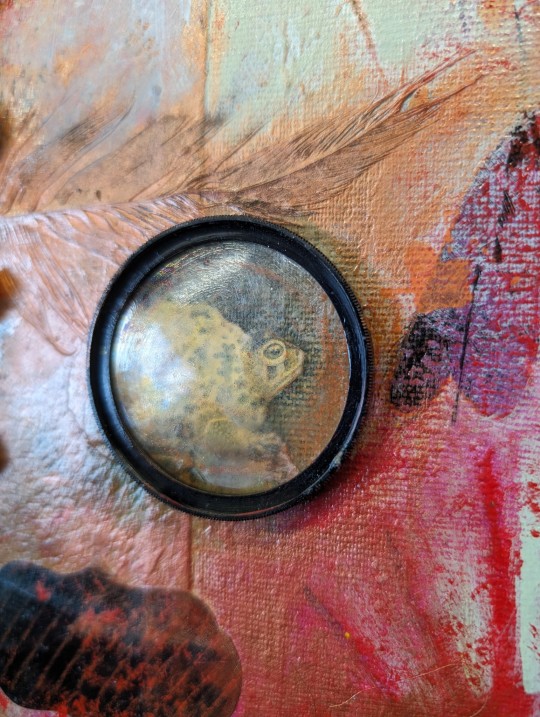
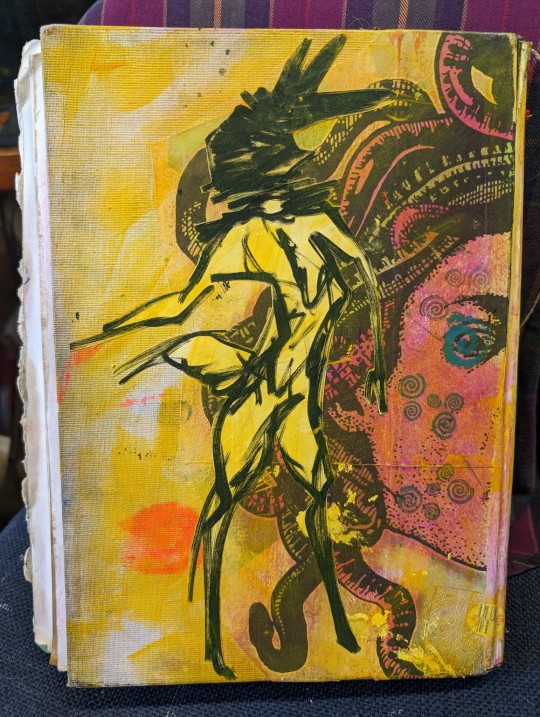

Here's what the Trash Book has been looking like lately. Always changing!
243 notes
·
View notes
Text
The Seven Deadly Sins: sins personified via animism and the church.
The arte of the witch is syncretic with the arte of demons. To usurp and overthrow the oppressor, and to cause sins within the souls of men. How does a witch do this? the Seven Deadly Sins or "cardinal sins" are the answer.
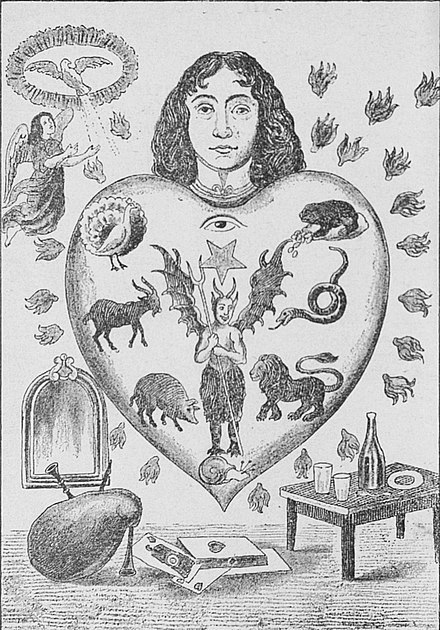
The image above depicts these 7 sins within the man's heart/soul as being animals. As an animist I can not help but view these animals as being true personification. Symbolism is not a thing to me, but a person. Although I'm sure the creator of this image was very much a good Catholic man who was not an animist, we can still utilize this image today as animists.
In traditional witchcraft it's common to call upon familiars associated with cardinal directions.a common example would be the toad, hare, serpent, and crow. However within my own arte I call upon the familiars of the cardinal sins pictured above.
The traditional meanings of these animals are as follows:
The toad- greed
The serpent- envy
The [mountain] lion- wrath
The snail- sloth
The pig- gluttony
The goat- lust
The peacock (or turkey) - pride.
This list although very eurocentric and representative of my own cosmology, can be reworked to fit your own landscape and culture. If you do not have any of the animals near you, change the list! Get to know the spirits of your land and assign your own familars to these sins.
In cases where the witch is cut off from nature, and the animals' parts are not on hand to conjure the spirit, there are demons traditionally associated with these sins as well. And demons are very present within the lives and bodies (posession)of man. The demons are changed in name and sinful virtue based on time period and culture. But the two most popular lists come from "the lantern of light" and Binsfield. Whichever resonates most is the answer.
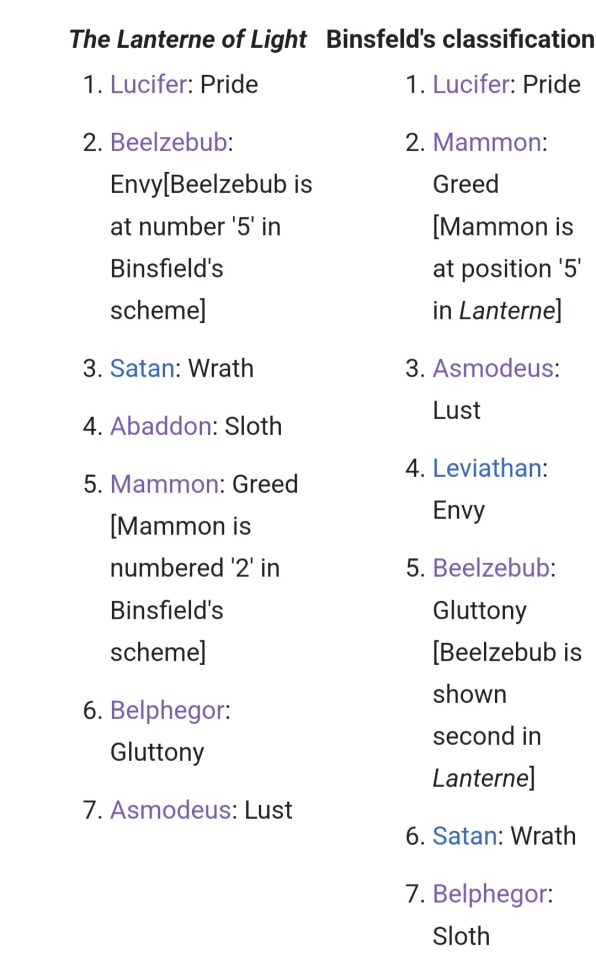
The witch may call upon these demons or animal familiars for the arte that is cursing man. What i consider man can very well be the gender or just all humanity (non witches) themselves. But these beliefs are very forcibly removed from modern witch-caucus.
As for the remedy for these sins, one must request the aid of the 7 heavenly virtues. These vurtues are as follows:

The heavenly virtues being the holy opposites of these Infernal spirits of demons or animals. These virtues are depicted as 7 angels, or 7 saints. Again, whichever list you prefer is the answer. The angels are a more modern concept applied by western occultusts. And are taken from my previous post on the 7 angels of planets. They are the main 7 Archangels found in Manila traditional catholic orders.
There are also lists of saints you can call against certain demons listed in the Pseudomonarchia Daemonum which i will share here



The work is never just left or right, but in between the holy and heretical. The saints and demons are beneficial to the witch just as they are to the church. With sin comes hell, and with the holy spirit comes heaven. God commands both, as do witches. Therefore I am now God.
#folk witchcraft#traditional witchcraft#transgender witches#beginner witch#folk catholicism#animism#santa muerte#folkloric witchcraft#witchcraft#ozark magic#demonology#demonolotry#grimoire#satanism#theistic satanism
66 notes
·
View notes
Text

All About Beltane
Beltane, also known as Bealtaine in Irish, is a Gaelic holiday traditionally held on May 1st or the halfway point between the spring equinox and the summer solstice. It is believed to be named after the Celtic sun god Belenus. It was widely observed in Ireland, Scotland, and the Isle Of Man, and is one of the 4 major Celtic fire festivals. It is mentioned in even the earliest Irish literature and marked the beginning of summer and used as the marker to drive cattle into their summer pastures. Although public celebrations have mostly fallen out after the 20th century and many traditions have been mixed with other cultural holidays (such as the Roman holiday May Day), many Celtic Neopagans and Wiccans still celebrate, and many local traditions still continue, causing it to now get a cultural revival.
Traditionally, rituals were held to protect the livestock that moved pastures, along with crops, dairy products, and people, and to encourage growth. It was also important to appease the Aos Sí, or nature spirits/fairies, which were believed to be more active then.
According to early medieval texts in 908, druids would make two bonfires and drive cattle between them to protect them from disease. In the 18th and 19th centuries, bonfires continued to be an important part of the celebrations. Before the bonfires were lit, all hearth fires were put out, and then relit using the fire from the Beltane bonfires after the celebration.
Continuing into the 19th century, cattle were still driven over or between flames, or sometimes around the fires or made to leap over. The people themselves did as well for good luck and protection. Once the fires died down, people would dab themselves with the ashes and sprinkle them over their crops and livestock. Torches from the bonfires would also be brought home and carried around the home or boundaries, and also used to relight the hearth.
Food was also an important part of the Beltane festival, and usually included a feast of lamb, which, historically, was sacrificed. In 1769, it was written that a hot drink, called a caudle, made of eggs, butter, oatmeal, and milk was served, along with tossing a bit on the ground as an offering. A Beltane Bannock, a type of oatmeal cake, was also written to be important and had a few traditions around it.
In one tradition, the Beltane Bannock had nine knobs on it and each person would take the bannock and face the fire, proceeding to break off the knobs of bannock one at a time and tossing them behind their shoulder as an offering to the spirits for protection over their livestock and from predators (one for the cow, one for the sheep, one for the fox, etc). Afterwards, they would drink the caudle.
According to other 18th century writers, there was another Beltane Bannock tradition where the bannock would be cut into slices and one was marked with charcoal. The slices were then thrown into a bonnet and everyone would take one out while blindfolded. According to one writer, whoever pulled the marked bannock slice had to leap through the fire 3 times. According to another, the person would instead be pretend-thrown into the fire and for some time afterward people would talk about the person as if they were dead. This may have always been symbolic, or it may have been a tradition from a time where actual human sacrifice was used. This tradition was also near identical to May Day traditions that occurred in Wales and other parts of Europe, however.
Other traditions including flowers and plants were also observed, especially ones that evoked fire. Documents from the 19th century cite that yellow and white flowers, such as primrose, rowan, hawthorn, gorse, hazel, and marsh marigold was used and placed at doorways and windows. Sometimes they were strewn into garland, and other times they were made into bouquets, made into crosses, or fastened to them. They were also fastened to cows and milking/butter equipment.
Decorating a May Bush or May Bough was also a widespread tradition, and it usually consisted of a small tree or branch (typically hawthorn, rowan, holly, or sycamore) decorated with bright flowers, ribbons, candles, painted shells or egg shells from Easter, and more. In some traditions they also decorated it with gold and silver May Balls, which were hurling balls, that were then either given out to children or gifted to winners of a hurling match. It was also known as the only acceptable time to cut a thorn tree, as they were associated with fairies and may have also been a relic of worshipping tree spirits. It would either be decorated where it grew, or branches hung over windows, doors, roofs, and barns either inside or outside. Traditionally, it was the responsibility of the eldest of the house to decorate it.
The tree was usually left up until May 31st, but in some traditions it would be burned in the festival bonfire after singing and dancing around it. In Dublin and Belfast, May Bushes were brought into town and decorated by the whole neighborhood, with each neighborhood competing for the most beautiful bush. These competitions could also lead to neighborhoods attempting to steal others May Bushes, which eventually led to the May Bush being outlawed in Victorian times.
Appeasing the fairies was also a big part in Beltane celebrations, with many traditions revolving around offerings to the fairies and also warding them off, as there were many fears around them stealing dairy. One protection tradition was to leave 3 black coals under the butter churn. Another was to hang May Boughs on the milk pails. And yet another was to hang cattle tails in the barns. Flowers were also used to decorate the cattle's horns for good luck.
Farmers would also lead a procession around the boundaries of the farm and would "carry with them seeds of grain, implements of husbandry, the first well water, and the herb vervain (or rowan)", stopping at the four cardinal points of direction starting at the east, and performing rituals towards each direction at each stop. These processions were said to bring protection of their farm produce and encourage fertility. Some people also made the sign of the cross using milk on the backside of cattle for good luck.
As for fairy offerings, one tradition was to pour milk or leave food at places associated with the fairies such as "fairy trees". In Ireland, cattle were brought to "fairy forts" where a small amount of their blood was poured into the earth with prayers of the herd's safety. Sometimes, the blood would be left to dry and then be burnt.
Visiting holy wells was also a popular way to celebrate Beltane. Visitors would walk sunwise, moving from east to west, around the well while praying for health. They would then leave offerings of coins or cloth. The first water drawn from the well on Beltane was thought to be especially potent, and would bring good luck to the person who drew it.
Morning dew on Beltane was also thought to bring goodluck and health, and maidens would wash their face with it or roll in it at dawn or before sunrise on Beltane. It was also collected in a jar, left in sunlight, and then filtered. The dew was said to increase sexual attractiveness, maintain youthfulness, protect from sun damage, and ensure skin health during the ensuing year.
Modern day celebrations may vary from these more traditional festival activities, but many choose to incorporate or take inspiration from the traditions at least. Popular traditions still revolve around bonfires, feasts, decorating a May Bush, and focusing on protection and growth.
Beltane Associations
Colors - yellow, white, red, green
Food - lamb, milk and dairy, beef, bannocks, caudle, cakes
Animals - cattle, sheep, other herd animals
Items - primrose, rowan, hawthorn, gorse, hazel, marsh marigold, holly, sycamore, yellow and white flowers, flower garland, greenery, morning dew, dairy products
Crystals - citrine, fire agate, fire opal, carnelian, red and yellow jasper
Other - protection, fertility, good luck, fire, smoke, ash, sun, bonfires, farming
Ways To Celebrate
light a bonfire
jump over or dance around a bonfire
decorate a May Bush or May Bough
craft and hang flower garland
bake Beltane Bannocks
collect morning dew
create some caudle
ward and protect your home or property
leave offerings for the fairies
focus on protection, growth, and luck magic
enjoy time in the sun
have a feast
create a bouquet out of yellow and white flowers
visit a farm or petting zoo
#beltane#beltaine#bealtaine#celtic#gaelic#irish#scottish#pagan#witch#witchy#wicca#may day#magick#magic#magickal#grimoire#tradition#celebrate#bonfire#fire festival#witchcraft#spiritual#witchblr#witch community#paganism#pagan witch#celtic paganism#paganblr#about#dairy
41 notes
·
View notes
Text
Why the Solomonic Tradition?
This probably deserves a more detailed, thought out post (scratch that - not “probably,” it definitely does), but here’s the quick-take, elevator-pitch version:
Solomonic Magick resonates with and satisfies the two sides of my personality:
The Abrahamic Religious side of me that wants to tap into the Celestial Divine and make full use of all aspects of Creation.
And the practical, down to earth side of me that wants to secure my finances, thwart thieves, and make my loud neighbors rue the day they ignored my polite requests they stop having 2am dance parties.
[elevator ding] Have a good one! Let me know if you have any questions!
30 notes
·
View notes
Text
https://t.me/libraryofdos
Check the tags for other channels.
#for all of your magickal literature needs#just remember to actually buy the book and support the authors#if this is posting it means I haven’t been active on here for a bit.#library of dos - occultism esotericism magick books & grimoires - magi realm - libraries of magick - serpents keep channel#old vk library of dos - library of magi - hidden one’s library - hora da magia - magick matters#there are several more#there are a lot of quasi- magic practitioners out there - so don’t listen to them about what you can or should or can’t or shouldn’t do#how you work with spirits only really matters to you and the spirits - don’t be an asshat but as long as you’re getting#The results and they’re not - guess who’s actually more right - somehow magic stopped#being about doing magic and started resembling some kind of weird clique#did the practitioners of old walk through the countryside asking for permission to practice their craft?#yeah I doubt it too#push the boundaries push your craft push yourself and find out what you’re capable of#if you don’t know what to do then just try something - you’ll figure it out#magic ends up being a very personal spiritual pursuit - so in someways you’re going to be on your own - so be good with being on your own#have some fire and a bit of force of nature about you - be different#magick#magic#grimoire tradition#lessons and magickal studies#winter solstice#happy birthday to me#I bid you all a fond farewell.
10 notes
·
View notes
Text
Wiccan Holidays
Here are the eight Wiccan holidays, known as Sabbats, along with their meanings and dates:
Samhain (pronounced "sow-in") - October 31st: This is the Wiccan New Year, a time to honor ancestors and loved ones who have passed away. It is also a time when the veil between the physical and spiritual worlds is believed to be thinnest, making it easier to communicate with spirits.
Yule - December 21st: The winter solstice marks the longest night of the year and the return of the sun. It is a time of introspection, renewal, and rebirth.
Imbolc (pronounced "im-bulk") - February 2nd: This is a time to celebrate the coming of spring and the awakening of the earth. It is also a time to honor the goddess Brigid, who represents inspiration, creativity, and healing.
Ostara - March 20th: The spring equinox is a time of balance between light and dark, and a time to celebrate new beginnings and growth. It is a time to honor the god and goddess as they prepare to conceive new life.
Beltane - May 1st: This is a celebration of fertility, sexuality, and the coming of summer. It is a time when the veil between the physical and spiritual worlds is thin, making it a powerful time for magic.
Litha (pronounced "lith-ah") - June 21st: The summer solstice marks the longest day of the year and the height of the sun's power. It is a time to celebrate the abundance of nature and the god's strength.
Lammas - August 1st: This is a time to honor the first harvest and the god's sacrifice, which allows us to have food and sustenance. It is a time to reflect on gratitude and abundance.
Mabon - September 21st: The fall equinox is a time of balance between light and dark, and a time to celebrate the second harvest. It is a time to reflect on the changing seasons and to prepare for the coming of winter.
These holidays are observed by many Wiccans and are a way to connect with the natural cycles of the earth and the divine energies that surround us.
{I myself am not a practicing Wiccan. I am just posting this for educational purposes & to share information to my followers}
#wicca#wiccan#wiccan holidays#wiccan traditions#wiccalife#witchblr#witchcore#witchcraft#witchlife#white witch#beginner witch#witch tips#grimoire#spirituality#book of shadows
201 notes
·
View notes
Text
Common Witchy Terms

Athame
A ceremonial knife, typically black handled with a double-edged blade. You use it to inscribe your candles or to cast a circle around the altar before commencing a spell.
Altar
A place where you do rituals or spells. It is often a special table or shelf where your ritual tools are kept.
Amulet
Is an object that is carried or worn on a person or placed in a location in order to draw specific energy or luck toward that person or location.
Book of Shadow
A Book of Shadows is a Witch's journal. It contains notes on experiments, information they picked up along the way, spells, recipes, correspondences, chants, traditions and more.
Coven
A coven is a community of witches who gather regularly for religious and/or social occasion.
Divination
Divination is the metaphysical work of finding the truth of an issue by using symbols and objects to interpret messages from the the collective unconscious or from communication with spirit beings.
Evoke
To call or summon a spirit or entity or deity.
Familiar
A familiar is a magic-user's spiritual helper manifest in animal form.
Grimoire
Is a magical manual or a magician's instruction book. It is much more formal than a Book of Shadows.
Hex
It refer to an unfriendly spell meant to bring about mischief.
Invoke
to summon or draw a spirit being into your own body. This is usually done to encourage communication between the spirit world and the material world.
Sachet
A small bag of herbs, crystals, or other objects that is meant to bring about a desired effect; essentially acts as a charm.
Ward
A protective barrier may be maintained by a spell, a talisman, a symbol or some other physical or energy object.
tip jar
#thecupidwitch#witchcraft#witch community#witchblr#witchcore#witches#witch#green witch#grimoire#spellwork#book of shadows#wicca#pegan#peganism#wiccablr#pagan wicca#wiccan#magic#ko fi support#baby witch#beginner witch#chaos witch#eclectic witch#folk witchcraft#hedge witch#kitchen witch#tarot witch#traditional witchcraft#witch aesthetic
149 notes
·
View notes
Text
March 2024 witch guide
Full moon: March 25th
New moon: March 10th
Sabbats: Ostara-March 19th
March Worm Moon
Known as: Crow Moon, Eagle Moon, Goose Moon, Hrethmonath, Lenting moon, Lentzinmanoth, Moon of Snowblind, Moon of Winds, Plow Moon, Sap Moon, Seed Moon, Sore Eyes Moon, Storm Moon, Sugar Moon & Wind Strong Moon
Element: Water
Zodiac: Pisces & Aries
Nature spirits: Air & water spirits & Mer-people
Deities: Artemis, Astarte, Athena, Cybele, Isis, Luna & Minerva
Animals: Boar, cougar & hedgehog
Birds: Sea crow & sea eagle
Trees: Alder, dogwood & honeysuckle
Herbs: Apple blossom, broom, high John root, Irish moss, pennyroyal, wood betony & yellow dock
Flowers: Daffodil, jonquil & violet
Scents: Apple blossom & honeysuckle
Stones: Aquamarine, bloodstone, jasper, opal &topaz
Colors: Pale-green, red, violet, yellow & white
Energy: Balance, beginnings, dream work, energy breaking into the open, exploring, fertility, inner development, karma, prosperity, spirituality, success & truth seeking
For many years, it was thought that the name "Worm Moon" referred to the earthworms that appear as the soil warms in spring. This invites robins and other birds to feed—a true sign of spring.
However, more research revealed another explanation. In the 1760s, Captain Jonathan Carver visited the Naudowessie (Dakota) and other Native American tribes and wrote that the name Worm Moon refers to a different sort of “worm”—beetle larvae—which begin to emerge from the thawing bark of trees and other winter hideouts at this time.
March’s full Moon often plays a role in religion, specifically in Christianity, this Moon is known as the Lenten Moon if it is the last full Moon of the winter season (i.e., if it occurs before the spring equinox) or as the Paschal Full Moon if it is the first full Moon of spring (i.e., if it occurs after the spring equinox).
Ostara
Known as: Alban Eiler, Lady Day & Spring/Vernal equinox
Season: Spring
Symbols: 8-spoked wheel, butterflies, chicks, decorated baskets, eggs, feathers, jellybeans, lambs, rabbits, seeds, shamrocks, spring flowers & sunwheels
Colors: Green, indigo, light blue, pastels, pink, red & yellow
Oils/Incense: African violet, florals, ginger, jasmine, lotus, magnolia, rose, sage & strawberry
Animals: Cormorant, hare, hawk, rabbit, sheep, sparrow & swallow
Mythical: Dragon & Unicorn
Stones: Amethyst, aquamarine, bloodstone, moonstone, red jasper & rose quartz
Food: Dairy foods, eggs(hard boiled), fruits, honey, honey cakes, leafy greens, vegetables, pine nuts, pumpkin, sunflower seeds, sprouts & waffles
Herbs/Plants: Acorn, cinquefoil, dogwood, ginger, Irish moss, olive, strawberry & woodruff
Flowers: Celandine, crocus, daffodil, dandelion, Easter lily, jasmine gorse, honeysuckle, hyssop, iris, jonquil, linden, narcissus, peony, snowdrop, tansy & violet
Goddesses: Aphrodite, Ariadne, Artemis, Athena, Coatlicue, Cybele,Demeter, Diana, Eos, Eostre, Flora, Gaia, Hera, Idunn, Iris, Ishtar, Juno, Minerva, Persephone, Venus & Vesta
Gods: Adonis, Attis, Celi, Cernunnos, Coel, Dagda, Dalon ap Landu, Dumuzi, Green Man, Lord of the Greenwood, Mithras, Odin, Osiris, Ovis & Pan
Issues, Intentions & Powers: Agriculture, balance, beauty, fertility, growth, life, love & rebirth/renewal
Spellwork: Air magick, fertility, new beginnings & water magick
Activities:
• Go on a hike/walk & look for signs of spring
• Add Ostara symbols to decorate your altar space
• Plant vegetable &/or flower seedlings
• Decorate eggs with bright colors
• Set your intentions for the weeks/months ahead
• Start a new class or hobby
• Create eggshell candles
• Make plans & new routines for the future
• Participate in rituals & ceremonies that connect you with energy & the life force of nature
• Have a feast with your friends &/family with sprouts & leafy greens
• Bake hot cross buns or lavender/lemon flavored treats
• Clean & de-clutter your home
• Try a re-birthing/ renewing ritual
• Bring fresh flowers or plants into into the home
• Host a spring & floral themed tea party
• Make egg based food dishes & desserts
This holiday marks the Spring Equinox, which happens before March 19-22. It is the second of three spring celebrations (the midpoint between Imbolc and Beltane) during which light & darkness are again in balance, with light on the rise. It is a time of new beginnings & of life emerging further from the grips of winter.
There is much debate regarding the origins of Ostara due to the lack of primary sources about this sabbat. One theory is the name of Ostara came from the Anglo-Saxon goddess Eostre. Another theory is that Eostre is more of a localized goddess in Kent County, England. Despite the questions of her origins, Eostre is associated with modern-day Pagan traditions of Ostara.
There is no evidence that the ancient Greeks or Romans celebrated Ostara, although they did celebrate their own spring festivals, such as the Roman festival of Floralia & the Greek festival of Anthesteria. It was a time to honor the returning sun, fertility & rebirth.
Related festivals:
• Nowruz- March 19th
Nowruz marks the first day of spring & renewal of nature. It is celebrated on the day of the astronomical vernal equinox. It is also celebrated as the beginning of the new year by people all around the world for over 3,000 years in the Balkans, the Black Sea Basin, the Caucasus, Central Asia, the Middle East & other regions.
It promotes values of peace & solidarity between generations & within families as well as reconciliation & neighbourliness. Nowruz plays a significant role in strengthening the ties among peoples based on mutual respect & the ideals of peace and good neighbourliness.
Traditional customs of Nowruz include fire & water, ritual dances, gift exchanges, reciting poetry, symbolic objects & more; these customs differ between the diverse peoples & countries that celebrate the festival.
• Holi- March 25th
Holi is a popular & significant Hindu festival celebrated as the The festival of colors, Love &Spring. It commemorates eternal and divine love of the deities Radha & Krishna. Additionally, the day signifies the triumph of good over evil, as it celebratess the victory of Vishnu as Narasimha over Hiranyakashipu. Holi originated & is predominantly celebrated in the Indian subcontinent, but has also spread to other regions of Asia & parts of the Western world through the Indian diaspora.
Holi also celebrates the arrival of Spring in India, the end of winter & the blossoming of love. It is also an invocation for a good spring harvest season. It lasts for a night & a day, starting on the evening of the Purnima (full moon day) falling on the Hindu calendar month of Phalguna, which falls around the middle of March in the Gregorian calendar.
• Easter- March 31st
also called Pascha or Resurrection Sunday is a Christian festival & cultural holiday commemorating the resurrection of Jesus from the dead, described in the New Testament as having occurred on the third day of his burial following his crucifixion by the Romans at Calvary c. 30 AD. It is the culmination of the Passion of Jesus Christ, preceded by Lent (or Great Lent), a 40-day period of fasting, prayer, & penance.
Easter traditions vary across the Christian world & include sunrise services or late-night vigils, exclamations & exchanges of Paschal greetings, flowering the cross & the decoration and the communal breaking of Easter eggs (a symbol of the empty tomb) among many others. The Easter lily is a symbol of the resurrection in Western Christianity traditionally decorates the chancel area of churches on this day & for the rest of Eastertide. Additional customs that have become associated with Easter & are observed by both Christians & some non-Christians include Easter parades, communal dancing, the Easter Bunny & egg hunting.
Other Celebrations:
• Festival of Luna- March 31st
Is a feast day honoring the Goddess Luna who is seen as the divine embodiment of the Moon.
The Temple of Luna was a temple on the Aventine Hill in Rome, dedicated to Luna, the moon goddess. Its dedication was celebrated on March 31st, thus the celebration.
According to Tacitus, it was built by king Servius Tullius. However, the first confirmed reference to a temple to Luna dates to 182 BC & refers to one of its doors being knocked off its posts by a miraculous blast of air & shot into the back of the Temple of Ceres. That account probably places the temple at the north end of the hill, just above porta Trigemina. The temple was struck by lightning around the time of the death of Cinna, as was the temple of Ceres. After the destruction of Corinth, Lucius Mummius Achaicus dedicated some of his spoils from the city to this temple. It was destroyed in the Great Fire of Rome in 64 AD & not rebuilt.
Sources:
Farmersalmanac .com
Llewellyn's Complete Book of Correspondences by Sandra Kines
Wikipedia
A Witch's Book of Correspondences by Viktorija Briggs
Encyclopedia britannica
Llewellyn 2024 magical almanac Practical magic for everyday living
#correspondences#sabbat#wheel of the year#ostara#Worm Moon#witch community#witchblr#wiccablr#paganblr#witchcraft#witches of tumblr#tumblr witch community#tumblr witches#full moon#witch guide#witch tips#traditional witchcraft#spellbook#grimoire#book of shadows#beginner witch#baby witch#full moon magick#witchcore#GreenWitchcrafts#pagan#wicca#witch#witchy tumblr#spells
231 notes
·
View notes
Text



*puts way too much thought into Grimoire covering his eyes at the beginning of Secret of the Swamp and the lines under his eyes that appear in certain expressions that are absent in Tangle Tower* I'm so normal. About them.
#detective grimoire#sally spears#i dont think im going to stop drawing pre-TT grimoire and sally anytime soon#tangle tower#art#secret of the swamp#traditional art
31 notes
·
View notes